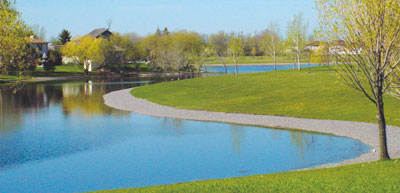Retention ponds are ponds or pools designed with additional storage capacity to attenuate surface runoff during rainfall events. They consist of a permanent pond area with landscaped banks and surroundings to provide additional storage capacity during rainfall events. They are created by using an existing natural depression, by excavating a new depression, or by constructing embankments. Existing natural water bodies should not be used due to the risk that pollution events and poorer water quality might disturb/damage the natural ecology of the system.
Retention ponds can provide both storm water attenuation and water quality treatment by providing additional storage capacity to retain runoff and release this at a controlled rate. Ponds can be designed to control runoff from all storms by storing surface drainage and releasing it slowly once the risk of flooding has passed. Runoff from each rain event is detained and treated in the pond. The retention time and still water promotes pollutant removal through sedimentation, while aquatic vegetation and biological uptake mechanisms offer additional treatment. Retention ponds have good capacity to remove urban pollutants and improve the quality of surface runoff.
Ponds should contain the following zones:
- a sediment forebay or other form of upstream pre-treatment system (i.e. as part of an upstream management train of sustainable drainage components)
- a permanent pool which will remain wet throughout the year and is the main treatment zone
- a temporary storage volume for flood attenuation, created through landscaped banks to the permanent pool
- a shallow zone or aquatic bench which is a shallow area along the edge of the permanent pool to support wetland planting, providing ecology, amenity and safety benefits.
Additional pond design features should include an emergency spillway for safe overflow when storage capacity is exceeded, maintenance access, a safety bench, and appropriate landscaping.
Well-designed and maintained ponds can offer aesthetic, amenity and ecological benefits to the urban landscape, particularly as part of public open spaces. They are designed to support emergent and submerged aquatic vegetation along their shoreline. They can be effectively incorporated into parks through good landscape design.
(Ponds installed primarily for wildlife benefit, or for other purposes besides management of runoff, may also be classified as measure N1).
| Benefits | Level |
|---|---|
|
ES1 - Water storage
|
Medium
|
|
ES3 - Natural biomass production
|
Medium
|
|
ES4 - Biodiversity preservation
|
High
|
|
ES5 - Climate change adaptation and mitigation
|
Medium
|
|
ES7 - Flood risk reduction
|
High
|
|
ES8 - Erosion/sediment control
|
Medium
|
|
ES9 - Filtration of pollutants
|
High
|
|
ES10 - Recreational opportunities
|
Medium
|
|
ES11 - Aesthetic/cultural value
|
High
|
|
PO2 - Improving status of physico-chemical quality elements
|
Low
|
|
PO4 - Improving chemical status and priority substances
|
Low
|
|
PO7 - Prevent surface water status deterioration
|
Medium
|
|
PO9 - Take adequate and co-ordinated measures to reduce flood risks
|
High
|
|
PO11 - Better protection for ecosystems and more use of Green Infrastructure
|
High
|
|
PO12 - More sustainable agriculture and forestry
|
Low
|
|
PO14 - Prevention of biodiversity loss
|
High
|
|
BP1 - Store runoff
|
High
|
|
BP2 - Slow runoff
|
High
|
|
BP5 - Increase evapotranspiration
|
Medium
|
|
BP8 - Reduce pollutant sources
|
Low
|
|
BP9 - Intercept pollution pathways
|
High
|
|
BP10 - Reduce erosion and/or sediment delivery
|
High
|
|
BP12 - Create aquatic habitat
|
High
|
|
BP13 - Create riparian habitat
|
Medium
|
|
BP14 - Create terrestrial habitats
|
Low
|
|
BP15 - Enhance precipitation
|
Low
|
|
BP16 - Reduce peak temperature
|
Low
|
